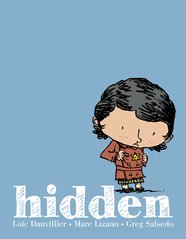2018 School Spending Survey Report
Hidden: A Child's Story of the Holocaust
tr. from French by Alexis Siegel. illus. by Marc Lizano and Greg Salsedo. 76p. First Second. Apr. 2014. Tr $16.99. ISBN 9781596438736.
COPY ISBN
Color by Greg Salsedo. In this graphic novel for younger readers, Elsa hears the story of her grandmother Dounia's childhood in Nazi-occupied France. The format helps reinforce the contrast between dark, scary moments and happier times, while the art also helps focus attention on the loving family and other people who helped Dounia. Small panels tell most of the story; large ones occasionally punctuate big moments.
In this graphic novel for younger readers, Elsa wakes up in the night and discovers her grandmother sitting in the dark, feeling sad. When Elsa asks why, she hears for the first time the story of her grandmother's childhood in Nazi-occupied France. Young Dounia's parents try to explain away the yellow star she must wear by calling it a sheriff's star, but she quickly realizes its true meaning when she begins to be treated very differently at school and in town. When the Nazis come to their apartment, her parents hide Dounia but are themselves taken away, and the terrified little girl is saved by a neighbor. A chain of people help her escape to the country, where she lives as a Catholic girl, with a new name. The graphic novel format helps reinforce the contrast between the dark, scary moments and the happier times in the countryside. The artists use small panels to tell most of the story, with words in the bottom right corners emphasizing Dounia's inner thoughts; large panels occasionally punctuate the big moments. While not disguising the ugliness of the events, the art also helps focus attention on the loving moments between Dounia and her parents, Dounia and the people who help her, and Dounia, Elsa, and her father (who also hears the story for the first time) all hugging one another at the end. susan dove lempke
ALREADY A SUBSCRIBER? LOG IN
We are currently offering this content for free. Sign up now to activate your personal profile, where you can save articles for future viewing





Be the first reader to comment.
Comment Policy:
Comment should not be empty !!!